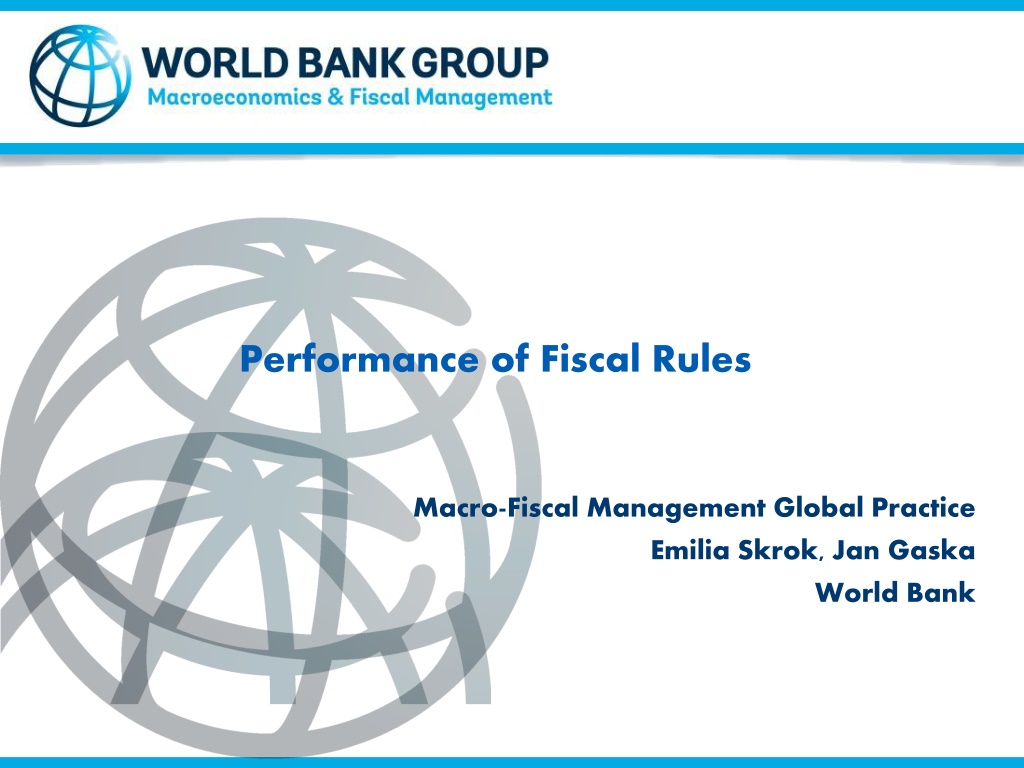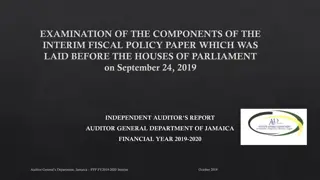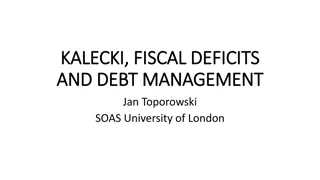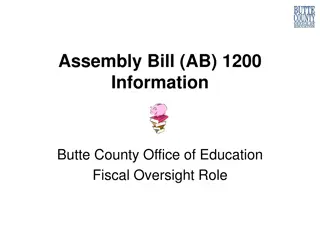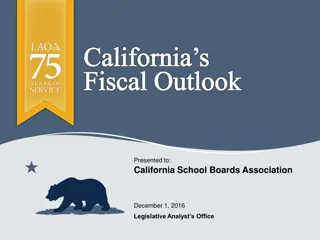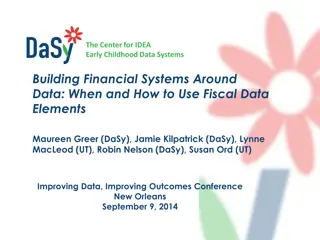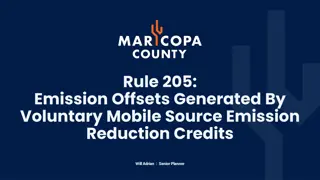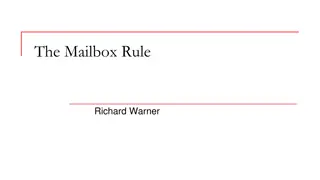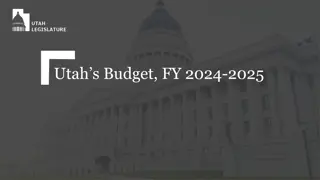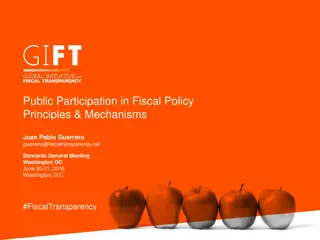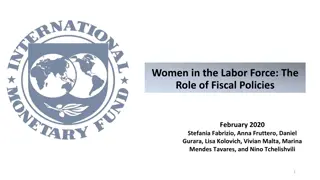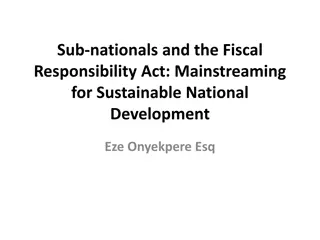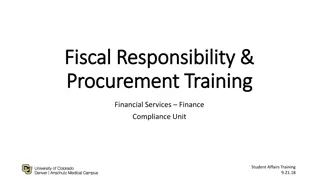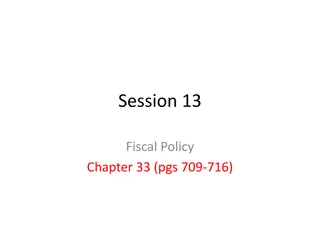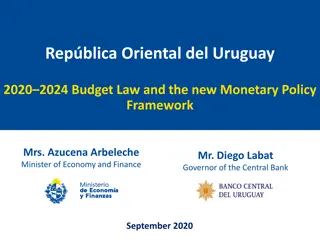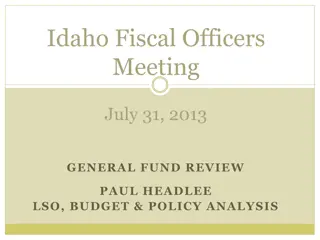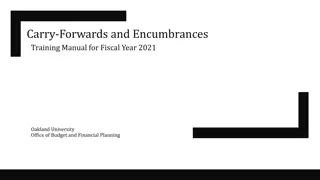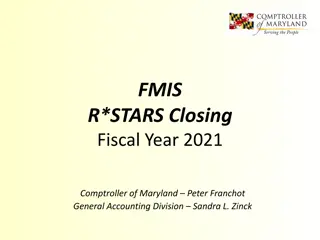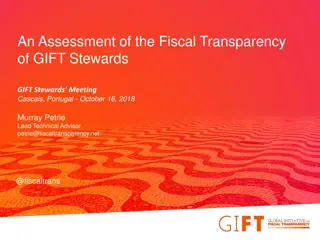Global Practices in Fiscal Rule Performance
The study explores the implementation and impact of fiscal rules on macro-fiscal management, focusing on international experiences. It discusses the presence and compliance with fiscal rules, highlighting differences in pro-cyclicality among small and large countries. The rise in adoption of national fiscal rules, particularly in the EU, is noted, emphasizing variations in rule implementation across regions and country sizes.
Download Presentation

Please find below an Image/Link to download the presentation.
The content on the website is provided AS IS for your information and personal use only. It may not be sold, licensed, or shared on other websites without obtaining consent from the author. Download presentation by click this link. If you encounter any issues during the download, it is possible that the publisher has removed the file from their server.
E N D
Presentation Transcript
Performance of Fiscal Rules Macro-Fiscal Management Global Practice Emilia Skrok, Jan Gaska World Bank
Outline 1. Setting the scene 2. Presence and compliance with FRLs 3. Performance of fiscal rules and lessons from international experience 2
Fiscal developments in the EU stand out globally Change in government net lending (2000-2017) Change in government debt (2000-2017) 30 5 20 4 10 3 0 2 -10 1 -20 0 -30 -1 -40 -2 -50 -3 -4 -60 world total non-EU EU (incl. NMS) NMS Bulgaria world total non-EU EU (incl. NMS) NMS Bulgaria below median above median below median above median 3
But fiscal policy in small NMS is more pro-cyclical than in bigger countries, EU and the rest of the world Procyclicality of fiscal policy Small NMS are characterized by more procyclical fiscal policy than the EU and non- EU, 0.9 0.8 0.7 0.6 0.5 Interestingly, in the non-EU countries smaller countries are less cyclical, 0.4 0.3 0.2 0.1 Bulgaria shows a bit higher spending procyclicality than the EU average. 0 world total non-EU EU (incl. NMS) NMS Bulgaria output gap vs. cycl. comp. of gov exp. below median above median Procyclicality of fiscal policy (understood as a correlation between cyclical part of government expenditures and output gap) 4
Presence, compliance and performance of fiscal rules: Lessons from international experience Presence Compliance Performance 5
Use of national fiscal rules is rising in all countries, with a faster pace in the EU Any national rule (excluding supranational rules) 100% 90% 80% 70% 60% 50% 40% 30% 20% 10% 0% 1990 1991 1992 1993 1994 1995 1996 1997 1998 1999 2000 2001 2002 2003 2004 2005 2006 2007 2008 2009 2010 2011 2012 2013 2014 2015 above median below median non-EU new EU EU15 6
Incidence of national fiscal rules: they are more common in EU countries as compared to non-EU, driven by use of fiscal rules in EU15. Size does not matter for the presence of fiscal rules globally. Non-EU countries tend to adopt less fiscal rules than EU countries (90% vs 61%), Differences regarding presence of fiscal rules by region and size of the country, (2015) Any rule NMS tend to adopt less fiscal rules than EU15 countries (85% and 93% respectively); 1 N:15 p:0.3 N:28 p:0 0.9 N:13 p:0.3 0.8 N:28 p:0.39 N:68 p:0.39 0.7 N:68 p:0 0.6 0.5 There is no statistically significant difference between frequency of adoption of FRs between smaller and bigger countries. 0.4 0.3 0.2 0.1 0 below median above median EU non-EU new EU EU15 Source: IMF, 2017 7
Significant drop in compliance of budget balance and debt rules around the global financial crisis, while compliance with expenditure rules has been higher since the crisis Whole sample: compliance by type of rule (compliance/all rules), 2000-2015 100 90 80 70 60 50 40 30 20 10 0 2000 2001 2002 2003 2004 2005 2006 2007 2008 2009 2010 2011 2012 2013 2014 2015 ER BBR DR 8
EU countries and in particular NMS show significantly higher compliance with fiscal rules than the rest of the world Average compliance, 2000-15, by region and size of the country (any type of rule) No significant differences in compliance between emerging and advanced countries (emerging countries show marginally better compliance ratio) 1 N:123 p:0.02 0.9 N:383 p:0.01 N:299 p:0.3 0.8 Average compliance rates in 2000-15 in EU countries were higher than in the rest of the world (71% vs 63%) 0.7 0.6 N:260 p:0.02 0.5 N:644 p:0.3 N:628 p:0.01 0.4 This was due to the compliance of NMS, which was significantly higher than the compliance of old EU. 0.3 0.2 0.1 0 EU EU15 non-EU new EU emerging advanced 9
Compliance is related to fiscal institutions, e.g. coverage of the rule and enforcement framework Average Fiscal Responsibility Index for different values of compliance variable Link between the strength of a fiscal rule (measured by Fiscal Responsibility Index) and its compliance exists but is not very strong. But individual components of the Fiscal Responsibility Index have positive and significant effects on compliance. Main factors favouring compliance are (based on probit model): a. Coverage of the rule (as defined in the IMF FAD database) the broader the coverage, the better for budget balance rule and debt rule compliance. b. Enforcement procedures (for budget balance rule compliance). 0.7 0.6 N:68 t:-2.04 p:0.04 N:216 t:1.93 p:0.05 0.5 N:170 t:-1.93 p:0.05 N:182 t:2.62 p:0.01 0.4 N:50 t:-2.62 p:0.01 0.3 N:157 t:2.04 p:0.04 0.2 0.1 0 DR BBR ER 10
Presence of expenditure rules reduces spending procyclicality, the strongest impact if combined with enforcement mechanism 1. Procyclicality Expenditure rule reduces procyclicality of government expenditure. The effect is reduced (but still significant) for small countries. Stabilizing capacities of expenditure rules could be enhanced by the presence of a fiscal institution (such as fiscal council or sovereign wealth fund). Compliance with expenditure rule do not impact spending cyclicality in statistically significant way Coefficients of FRLs impact on 10-year Procyclicality of Government Expenditure 0.0397 0 0.5 0.0172 -0.088 -0.5 -0.479 -0.546 -1 -0.726 -0.754 -1.5 -1.511 -2 -2.5 -3 -3.065 -3.5 11 Note: the solid fill indicates statistical significance
Balance and Debt rules improve fiscal sustainability, compliance with balance budget rules increases the impact 2. Primary balance reaction function Two fiscal rules balance and debt rules - improve fiscal sustainability (increase the response of primary balance to change in debt) These rules increase the reaction of primary balance to change in debt by 0.6 0.8 percentage points of GDP per each 10 percentage points increase in debt. The values for coefficients (reaction of primary balance to changes in debt) for different measures of fiscal rules Compliance with budget balance rule gives much better results than the presence of this rule without compliance For debt rule impact on fiscal sustainability there is little difference between compliance and presence of debt rule (this may reflect a design of the debt rule) Presence and compliance of expenditure rule do not have statistically significant impact on sustainability (in line with expectation). 0.10 0.08 0.06 0.04 0.02 0.00 -0.02 BBR presence BBR DR presence DR ER presence ER compliance compliance compliance Note: the solid fill indicates statistical significance 12
Combination of rules produces positive impact on fiscal sustainability, in particular expenditure rule + debt rule after the crisis Combination of fiscal rules after the crisis, in particular DR+ER and DR+BBR proved to provide a greater anchor for debt sustainability This two combinations increases the reaction of primary balance to change in debt by 1.5 1.8 percentage points of GDP per each 10 percentage points increase in debt. The values for coefficients (reaction of primary balance to changes in debt) for presence of different types of FRs 0.2 0.15 0.1 0.05 0 -0.05 -0.1 -0.15 BBR&DR BBR&DR after crisis BBR&ER BBR&ER after crisis DR&ER DR&ER after crisis Note: the solid fill indicates statistical significance 13
Conclusions The mere presence of a fiscal rule does not guarantee its effectiveness. EU countries, and especially NMS, have higher compliance with fiscal rules than the rest of the world. A strong institutional and policy framework improves compliance with fiscal rules. Countries that adopt and adhere to fiscal rules have improved fiscal balances and enhanced debt-sustainability indicators Adopting and complying with expenditure rules tend to reduce expenditure procyclicality. Combining rules intensifies their positive impact on debt sustainability. 14
Relation between fiscal rules and economic size has not been assessed 17
Main Findings of LAC study Smaller countries have business cycles with particular characteristics: GDP is more volatile, cycles are asymmetric with deeper contractions and more procyclical fiscal policy. Due to prevalence of fixed exchange rate regimes in small countries fiscal policy is even more critical for these countries. Fiscal rules (FRs) can be an important tool in this regard. The analysis of FRs across countries shows that having FRs improves several fiscal outcomes. FRs are less common in small countries (as compared to big ones), DRs and BBRs are the most common globally, but use of ERs has been on rise. There is no difference in compliance between small and large countries, BUT small LAC have significantly lower compliance. In the case of small countries the most complied rule is DRs (79%), although compliance on ERs is on the rise. The same is true for LAC with strong increase of compliance with ERs. Presence of ERs reduces spending procyclicality, the strongest impact if combined with enforcement mechanisms (e.g., fiscal council). Presence of the combination of fiscal rules after the crisis, in particular DRs+ERs and DRs+BBRs enhance debt sustainability 18
Smaller countries have slower growth rates and higher volatility (not true for NMS and the EU) EU shows slower but a more stable growth and fiscal position than non-EU GDP and gross national savings growth, 2000-17 Volatility of GDP and Private Consumption Growth and of Fiscal Balance changes, 0.07 0.3 0.06 0.25 0.05 0.2 0.04 0.15 0.03 0.1 0.02 0.05 0.01 0 0 NMS NMS EU (incl. NMS) EU (incl. NMS) non-EU non-EU world total world total Bulgaria Bulgaria NMS NMS NMS EU (incl. NMS) EU (incl. NMS) EU (incl. NMS) non-EU non-EU non-EU world total world total world total Bulgaria Bulgaria Bulgaria GDP growth Gross national savings growth GDP growth Gross national savings growth Change in fiscal balance as a pct. Of GDP below median above median below median above median 19
EU uses more national FRLs of each kind than the rest of the world. NMS use less BBRs and ERs than EU15 countries, but more DRs. Differences regarding presence of fiscal rules by type of rule, region and size of the country, 2015 EU countries use more national BBRs and ERs than other parts of the world. The difference in use of national DRs is much smaller. Budget balance rule Debt rule N:15 p:0.31 1 1 N:28 p:0.4 N:13 p:0.01 N:68 p:0.22 N:28 p:0 0.8 0.8 N:68 p:0.34 N:28 p:0.34 N:68 p:0.4 0.6 0.6 N:68 p:0 N:13 p:0.31 0.4 0.4 N:15 p:0.01 N:28 p:0.22 0.2 0.2 0 0 If compared to EU15, NMS use less of national ERs and BBRs (but not significantly), but much more DRs. EU EU15 EU EU15 non-EU non-EU below median new EU below median new EU above median above median Expenditure rule 1 Size does not matter for use of BBRs, but small countries tend to use less of ERs and DRs. 0.8 N:15 p:0.2 0.6 N:28 p:0.02 N:13 p:0.2 N:68 p:0.29 0.4 N:28 p:0.29 N:68 p:0.02 0.2 0 Source: IMF, 2015 EU EU15 non-EU below median new EU above median 20
The combination of rules are used more in the EU, in particular in NMS than in other countries. Smaller countries tend to use 2+ rules less often The most common combination of rule globally is BBR plus DR, followed by BBR plus ER. Same is true for EU. EU countries use more combination of rules (BBR + DR , BBR+ER, DR+ER) than other countries, though differences are not statistically significant. However, when NMS are compared with EU15, they use more the combination of rules, though only in case of BBR+DR the difference is statistically significant. Interestingly, EU15 use less BBR+DR combination that non-EU countries. Differences regarding presence of fiscal rules by type of rule, region and size of the country, 2015 BBR+DR ER+DR 1 1 0.8 0.8 N:13 p:0.02 0.6 0.6 N:28 p:0.19 N:13 p:0.12 0.4 0.4 N:68 p:0.34 N:28 p:0.34 N:68 p:0.19 N:28 p:0.17 N:68 p:0.23 N:15 p:0.02 0.2 0.2 N:15 p:0.12 N:68 p:0.17 N:28 p:0.23 0 0 Source: IMF, 2015 EU non-EU below median above median new EU EU15 below median above median EU non-EU new EU EU15 21 -0.2 -0.2
Overall compliance of bigger (above median) and smaller (below median) countries is similar, though smaller countries are more compliant with BBRs while bigger with ERs Budget balance rule Any rule 100 100 90 90 80 80 70 70 60 60 50 50 40 40 30 30 20 20 10 10 0 0 below median above median below median above median Debt rule Expenditure rule 100 100 90 90 80 80 70 70 60 60 50 50 40 40 30 30 20 20 10 10 0 0 below median above median below median above median 22
Compliance varies according to rule and region Budget Balance Rule (BBR) 1 Debt Rule (DR) The most complied rule globally is DR (77%) and the least complied BBR (55%) 1 N:106 p:0 0.9 N:63 p:0.03 0.9 0.8 N:146 p:0.33 N:296 p:0.33 0.7 0.8 0.6 0.7 0.5 N:43 p:0.03 N:312 t:1.03 p:0.23 N:107 p:0.39 0.6 N:39 p:0.39 The most complied rule in EU is DR (81%), the least complied BBR (58%) only slightly above respective compliance rates in other regions. 0.4 N:188 p:0.24 N:106 t:-1.03 p:0.23 0.3 0.5 N:188 p:0 N:109 p:0.24 0.2 0.4 0.1 0.3 0 advanced EU non-EU emerging old EU new EU 0.2 0.1 0 advanced EU15 EU non-EU emerging new EU Expenditure Rule (ER) N:84 p:0.37 The most complied rule in NMS is DR (94%), the least complied BBR (56%). N:21 p:0.38 N:131 p:0.34 1 0.9 0.8 0.7 0.6 0.5 N:144 p:0.37 N:144 p:0.34 N:110 p:0.38 No big difference in compliance with ER across countries. 0.4 0.3 0.2 0.1 0 advanced EU old EU non-EU emerging new EU 23
